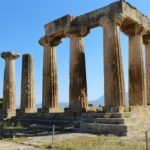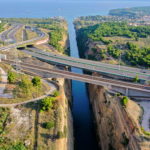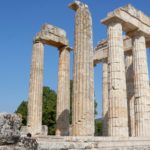9 Hours
Private Tour
English
UP TO 14 GUESTS
Wine Roads Private Day Tour: Corinth-Ancient Nemea & Wine Tasting
Got a Question?
Contact UsHighlights
Wine roads Private tour
- Corinth Canal
- Ancient Corinth – Temple of Apollo
- Acrocorinth
- Ancient Nemea
- Nemea Wine Roads (wine tasting)
- The picturesque town of Nafplio – Palamidi – Bourtzi
Itinerary
This tour addresses to those who are not only interested in the imposing archaeological sites of the Greek countryside but would also like to taste the famous Greek wine of Nemea by visiting one of its wineries. The region has produced the most qualitative and tasteful wine in Greece for thousands of years.
The tour starts with a drive along the coast, on the way you will view of some Greek seaside villages and the island of 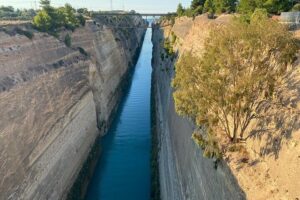 Salamis (where the historical naval battle took place between the Athenians and the Persians). Our first stop the Corinth Canal. Opened in 1892 separating the Peloponnese peninsula from the rest of Greece and connecting the Saronic Gulf to the Corinthian Sea. You will have time to walk across on a pedestrian bridge to admire the canal closer, for the adventurous on some days bungee jumping, is an option.
Salamis (where the historical naval battle took place between the Athenians and the Persians). Our first stop the Corinth Canal. Opened in 1892 separating the Peloponnese peninsula from the rest of Greece and connecting the Saronic Gulf to the Corinthian Sea. You will have time to walk across on a pedestrian bridge to admire the canal closer, for the adventurous on some days bungee jumping, is an option.
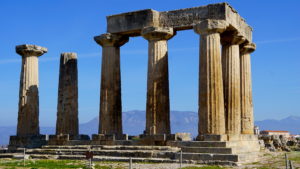 Continuing we will drive you to Ancient Corinth. Historically the city was dominated by the hill of Acrocorinth, the old Castle, the oldest and largest castle in southern Greece. The site located at the base of the hill includes the Roman Agora of Corinth, the Temple of God Apollo and a small museum. In addition to its archaeological and historical interest, Ancient Corinth is also one of the most popular religious destinations in Greece. It was here that the Apostle Paul preached Christianity, was judged by the tribunal in the Agora and established the best organized Christian church of the time.
Continuing we will drive you to Ancient Corinth. Historically the city was dominated by the hill of Acrocorinth, the old Castle, the oldest and largest castle in southern Greece. The site located at the base of the hill includes the Roman Agora of Corinth, the Temple of God Apollo and a small museum. In addition to its archaeological and historical interest, Ancient Corinth is also one of the most popular religious destinations in Greece. It was here that the Apostle Paul preached Christianity, was judged by the tribunal in the Agora and established the best organized Christian church of the time.
 Our Next stop will be the site of Ancient Nemea. Nemea is mainly known for the Nemean Games the ancient Greek stadium and the Temple of Zeus but also for the vineyards. Nemea has the most wineries in Greece as grape growing has been a tradition here since ancient times. In the site apart for the museum and the sanctuary, the stadium makes the difference. One of the best-preserved stadiums, located on a higher level still preserves the tunnel through which the athletes entered the stadium.
Our Next stop will be the site of Ancient Nemea. Nemea is mainly known for the Nemean Games the ancient Greek stadium and the Temple of Zeus but also for the vineyards. Nemea has the most wineries in Greece as grape growing has been a tradition here since ancient times. In the site apart for the museum and the sanctuary, the stadium makes the difference. One of the best-preserved stadiums, located on a higher level still preserves the tunnel through which the athletes entered the stadium.
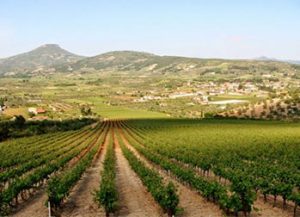 After the visit to the site, we will head towards one of the Nemean wineries. Driving through the grape yards of the largest wine production zone in Greece, we will visit one of the best wineries. People will gladly give you a small tour showing you the grape yards, the storage barrels, explaining you the procedure that takes place until the bottling. In the end, you will be offered to taste some of their best varieties while having a view of the Nemean Valley.
After the visit to the site, we will head towards one of the Nemean wineries. Driving through the grape yards of the largest wine production zone in Greece, we will visit one of the best wineries. People will gladly give you a small tour showing you the grape yards, the storage barrels, explaining you the procedure that takes place until the bottling. In the end, you will be offered to taste some of their best varieties while having a view of the Nemean Valley.
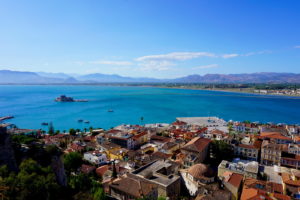 Lastly, we will drive towards the city of Nafplio for our last stop, considered the most scenic city, it functioned as the capital of Greece until 1834. It offers you an outstanding combination of fortresses and castles (Palamidi, Bourtzi), a huge port opened to the Aegean Sea and the unique architecture of the old city of Nafplion revealing Venetian, neoclassical and oriental elements.
Lastly, we will drive towards the city of Nafplio for our last stop, considered the most scenic city, it functioned as the capital of Greece until 1834. It offers you an outstanding combination of fortresses and castles (Palamidi, Bourtzi), a huge port opened to the Aegean Sea and the unique architecture of the old city of Nafplion revealing Venetian, neoclassical and oriental elements.
After walking in the idyllic old city we will stop for lunch at a traditional tavern by the sea and drive up to the castle of Acronafplia for a panoramic view of Nafplio. Then we will start for our way back following the eastern coast of Peloponnese peninsula to reach Athens again.
Inclusions - Exclusions
Private Tours are personal and flexible just for you and your party.
Inclusions:
-
Professional Drivers with Deep knowledge of history [Not licensed to accompany you in any site]
-
Hotel pickup and drop-off
-
Transport by private vehicle
- Wine Tasting
- Bottled water
Exclusions:
- Entrance Fees [25€ for over 18 yo for Non EU & 25 yo for EU Citizens]
- Licensed Tour guide upon request depending on availability [Additional cost – 380 €]
- Airport Pick Up and drop-off (Additional cost)
- Food & Drinks
Entrance Fees
ADMISSION FEES FOR SITES:
Summer Period: 25€ per person
(1 April – 31 October)
Ancient Corinth: 15€ (08:00am- 20:00pm)
Ancient Nemea: 10€ (08:00am- 17:00pm)
Winter Period: 25€ per person
(1 November – 31 March)
Ancient Corinth: 15€ (08:00am- 15:30pm)
Ancient Nemea: 10€ (08:00am- 15:30pm, Tuesday closed)
Free admission days:
- 6 March (in memory of Melina Mercouri)
- 18 April (International Monuments Day)
- 18 May (International Museums Day)
- The last weekend of September annually (European Heritage Days)
- Every first and third Sunday from November 1st to March 31st
- 28 October
Holidays:
- 1 January: closed
- 25 March: closed
- 1 May: closed
- Easter Sunday: closed
- 25 December: closed
- 26 December: closed
Free admission for:
- Children & young people up to the age of 25 from EU Member- States
- Children & young people from up to the age of 18 from Non- European Union countries
- Persons over 25 years, being in secondary education & vocational schools from EU Member- States
- Escorting teachers during the visits of schools & institutions of Primary, Secondary & Tertiary education from EU Member- States
- People entitled to Social Solidarity income & members depending on them
- Persons with disabilities & one escort (only in the case of 67% disability)
- Refugees
- Official guests of the Greek State
- Members of ICOM & ICOMOS
- Members of societies & Associations of friends of State Museums & Archaeological sites
- Scientists licensed for photographing, studying, designing or publishing antiquities
- Journalists
- Holders of a 3- year Free Entry Pass
Reduced admission for:
- Senior citizens over 65 from Greece or other EU member-states, during
the period from 1st of October to 31st of May - Parents accompanying primary education schools visits from EU Member- States
- Escorting teachers of educational visits of schools & institutions of primary, secondary & tertiary education from non European Union countries
Reduced & free entrance only upon presentation of the required documents
History
Corinth Canal:
The famous Corinth Canal connects the Gulf of Corinth with the Saronic Gulf in the Aegean Sea. It cuts through the narrow Isthmus of Corinth and separates the Peloponnesian peninsula from the Greek mainland, thus effectively making the former an island. The canal is 6.4 kilometers in length and only 21.3 meters wide at its base. Earth cliffs flanking either side of the canal reach a maximum height of 63 meters. Aside from a few modest-sized cruise ships, the Corinth Canal is unserviceable to most modern ships. The Corinth Canal, though only completed in the late 19th century, was an idea and dream that dates back over 2000 thousand years.
Before it was built, ships sailing between the Aegean and Adriatic had to circumnavigate the Peloponnese adding about 185 nautical miles to their journey. The first to decide to dig the Corinth Canal was Periander, the tyrant of Corinth (602 BCE). Such a giant project was above the technical capabilities of ancient times so Periander carried out another great project, the diolkós, a stone road on which the ships were transferred on wheeled platforms from one sea to the other. Dimitrios Poliorkitis, king of Macedon (c. 300 BCE), was the second who tried, but his engineers insisted that if the seas where connected, the more northerly Adriatic, mistakenly thought to be higher, would flood the more southern Aegean. At the time, it was also thought that Poseidon, god of the sea, opposed joining the Aegean and the Adriatic. The same fear also stopped Julius Caesar and Emperors Hadrian and Caligula. The most serious try was that of Emperor Nero (67 CE). He had 6,000 slaves for the job. He started the work himself, digging with a golden hoe, while music was played. However, he was killed before the work could be completed.
In the modern era, the first who thought seriously to carry out the project was Capodistrias (c. 1830), first governor of Greece after the liberation from the Ottoman Turks. But the budget, estimated at 40 million French francs, was too much for the Greek state. Finally, in 1869, the Parliament authorized the Government to grant a private company (Austrian General Etiene Tyrr) the privilege to construct the Canal of Corinth. Work began on Mar 29th, 1882, but Tyrr’s capital of 30 million francs proved to be insufficient. The work was restarted in 1890, by a new Greek company (Andreas Syggros), with a capital of 5 million francs. The job was finally completed and regular use of the Canal started on Oct 28th, 1893. Due to the canal’s narrowness, navigational problems and periodic closures to repair landslips from its steep walls, it failed to attract the level of traffic anticipated by its operators. It is now used mainly for tourist traffic. The bridge above is perfect for bungee jumping.
Ancient Corinth:
Located close to the isthmus which connects mainland Greece with the Peloponnese, surrounded by fertile plains and blessed with natural springs, Corinth was an important city in Greek, Hellenistic and Roman times. Its geographical location helped it play a role as a center of trade, naval fleet, participation in various Greek wars and status as a major Roman colony meant the city was, for over a millennium, rarely out of the limelight in the ancient world.
CORINTH IN MYTHOLOGY
Not being a major Mycenaean center, Corinth lacks the mythological  heritage of other Greek city-states. Nevertheless, the mythical founder of the city was believed to have been King Sisyphus, famed for his punishment in Hades where he was made to forever roll a large boulder up a hill. Sisyphus was succeeded by his son Glaucus and his grandson Bellerophon, whose winged-horse Pegasus became a symbol of the city and a feature of Corinthian coins. Corinth is also the setting for several other episodes from Greek mythology such as Theseus’ hunt for the wild boar, Jason settled there with Medea after his adventures looking for the Golden Fleece, and there is the myth of Arion – the real-life and gifted kithara player and resident of Corinth – who was rescued by dolphins after being abducted by pirates.
heritage of other Greek city-states. Nevertheless, the mythical founder of the city was believed to have been King Sisyphus, famed for his punishment in Hades where he was made to forever roll a large boulder up a hill. Sisyphus was succeeded by his son Glaucus and his grandson Bellerophon, whose winged-horse Pegasus became a symbol of the city and a feature of Corinthian coins. Corinth is also the setting for several other episodes from Greek mythology such as Theseus’ hunt for the wild boar, Jason settled there with Medea after his adventures looking for the Golden Fleece, and there is the myth of Arion – the real-life and gifted kithara player and resident of Corinth – who was rescued by dolphins after being abducted by pirates.
HISTORICAL OVERVIEW
The city was first inhabited in the Neolithic period (c. 5000 BCE) but became more densely populated from the 10th century BCE. The historical founders were the aristocratic descendants of King Bacchis, the Bacchiadae (in c. 750 BCE). The Bacchiadae ruled as a body of 200 until in c. 657 BCE when the popular tyrant Cypselus took control of the city, to be succeeded by his son Periander (re. c. 627-587 BCE). Cypselus funded the building of a treasury at Delphi and set up new colonies
From the 8th century BCE, Corinthian pottery was exported across Greece. With its innovative figure decoration, it dominated the Greek pottery market until the 6th century BCE when Attic black-figure pottery took over as the dominant style. Other significant exports were Corinthian stone and bronze wares. Corinth also became the hub of trade through the diolkos. This was a stone track with carved grooves for wheeled wagons which offered a land short-cut between the two seas and probably dates to the reign of Periander. In the Peloponnesian War, the diolkos was even used to transport triremes. Although the idea for a canal across the isthmus was first considered in the 7th century BCE and various Roman Emperors from Julius Caesar to Hadrian began surveys, it was Nero who actually began the project (67 CE). However, on the emperor’s death, the project was abandoned, not to be resumed until 1881 CE.
From the early 6th century BCE, Corinth administered the PanHellenic games at nearby Isthmia, held every two years in the spring. These games were established in honor of Poseidon and were particularly famous for their horse and chariot races.
An oligarchy, consisting of a council of 80, gained power in Corinth (585 BCE). Concerned with a local rival, Argos. From 550 BCE Corinth became an ally of Sparta during Cleomenes’ reign though, the city became wary of the growing power of Sparta and opposed Spartan intervention in Athens. Corinth also fought in the Persian Wars against the invading forces of Xerxes which threatened the autonomy of all of Greece.
Corinth suffered badly in the First Peloponnesian War, which it was responsible for after attacking Megara. Later it was also guilty of causing the Second Peloponnesian War, in 433 BCE. Once again though, the Corinthians, mainly as Sparta’s naval ally, had a disastrous war. Disillusioned with Sparta’s reluctance to completely destroy and concerned over Spartan expansion in Greece and Asia Minor, Corinth formed an alliance with Argos, Boeotia, Thebes and Athens to fight Sparta in the Corinthian Wars (395-386 BCE). The conflict was fought at sea and on Corinthian territory and was yet another costly endeavor for the citizens of Corinth.
Corinth became the seat of the Corinthian League, but losing a war against Philip II of Macedon (338 BCE) this ‘honor’ was a Macedonian garrison being stationed on the Acrocorinth acropolis overlooking the city.
A succession of Hellenistic kings took control of the city – starting with Ptolemy I and ending with Aratus in 243 BCE when Corinth joined the Achaean League. However, the worst was yet to come, when the Roman commander Lucius Mummius destroyed the city (146 BCE).
A brighter period was when Julius Caesar took charge (in 44 BCE) and organized the agricultural land into organized plots (centuriation) for distribution to Roman settlers. The city once more flourished, by the 1st century CE it became an important administrative and trade center again. In addition, following St. Paul’s visit between 51 and 52 CE, Corinth became the center of early Christianity in Greece. In a public hearing, the saint had to defend himself against accusations from the city’s Jewish that his preaching undermined the Mosiac Law. The pro-consul Lucius Julius Gallio judged that Paul had not broken any Roman Law and so was permitted to continue his teachings. From the 3rd century CE, the city began to decline and the Germanic tribes attacked the city.
THE ARCHAEOLOGICAL SITE
In Ancient Corinth, there were cults to Aphrodite (protector of the city), Apollo, Demeter Thesmophoros, Hera, Poseidon and Helios and various buildings to cult heroes, the founders of the city. In addition, there were several sacred springs, the most famous being Peirene. Unfortunately, the destruction in 146 BCE erased much of this religious past. In Roman Corinth, Aphrodite, Poseidon and Demeter did continue to be worshiped along with the Roman gods.
The site today, first excavated in 1892 CE by the Greek Archaeological Service, is dominated by the Doric peripteral Temple of Apollo (c. 550-530 BCE), originally with 6 columns on the façades and 15 on the long sides. A particular feature of the temple is the use of monolithic columns rather than the more commonly used column drums. 7 columns remain standing today.
The majority of the other surviving buildings date from the 1st century CE in the Roman era and include a large forum, a temple to Octavia, baths, the Bema where St. Paul addressed the Corinthians, the Asklepeion temple to Asclepius and a centre of healing, fountains – including the monumental Peirine fountain complex (2nd century CE) – a propylaea, theatre, odeion, gymnasium and stoas. There are also the remains of three basilicas.
Archaeological finds at the site include many fine mosaics – notably the Dionysos mosaic – Greek and Roman sculpture – including an impressive number of busts of Roman rulers.
Acrocorinth:
The steep rock of the Acrocorinth rises to the south-west of ancient Corinth, surmounted by the fortress, also called the Acrocorinth, which was the fortified citadel of ancient and medieval Corinth and the most important fortification work in the area from antiquity until the Greek War of Independence in 1821. It is 575 m. high and its walls are a total of almost 2.000 m. in length.
The ascent to Acrocorinth – Acrocorinthos, is facilitated by a road which  climbs to a point near the lowest gate on the west side. This commanding site was fortified in ancient times and its defenses were maintained and developed during the Byzantine, Frankish, Turkish and Venetian periods. After a moat (alt. 380 m -1247 feet) constructed by the Venetians follow the first gate, built in the Frankish period (14th,c.) and the first wall 15th c. then come the second and third walls (Byzantine: on the right, in front of the third gate, a Hellenistic tower). Within the fortress we follow a path running north-east to the remains of a mosque (16th c.) and then turn south until we join a path leading up to the eastern summit, on which there once stood the famous Temple of Aphrodite, worshiped here after the Eastern fashion (views of the hills of the Peloponnese and of Isthmus).
climbs to a point near the lowest gate on the west side. This commanding site was fortified in ancient times and its defenses were maintained and developed during the Byzantine, Frankish, Turkish and Venetian periods. After a moat (alt. 380 m -1247 feet) constructed by the Venetians follow the first gate, built in the Frankish period (14th,c.) and the first wall 15th c. then come the second and third walls (Byzantine: on the right, in front of the third gate, a Hellenistic tower). Within the fortress we follow a path running north-east to the remains of a mosque (16th c.) and then turn south until we join a path leading up to the eastern summit, on which there once stood the famous Temple of Aphrodite, worshiped here after the Eastern fashion (views of the hills of the Peloponnese and of Isthmus).
Parts of roughly dressed polygonal masonry allow us to suppose that the Acrocorinth was fortified as early as the time of the Kypselid tyranny (late 7th c. early 6th c. BCE). The surviving parts of the ancient fortifications, however, which are at many points beneath the medieval enceinte, belong mainly to the 4th c. BCE. In 146 BCE, Mummius destroyed the fortifications of the lower city and the Acropolis. The destroyed sections were subsequently reconstructed. During the Middle Ages, the Acrocorinth was of prime importance for the defense of the entire Peloponnese and held out against the attacks of the barbarians. The Byzantines sporadically repaired the walls, especially after hostile raids (by the Slavs, Normans and others) and added new fortifications on the west side of the fortress. In 1210, after a five-year siege, the Acrocorinth was captured by Otto de la Roche and Geoffroy I Villehardouin and was incorporated in the Frankish principate of Achaea. In the middle of this century, William Villehardouin extended the fortifications of the fortress, to be followed in this by the Angevin Prince John Gravina at the beginning of the 14th c.
In 1358 the Acrocorinth passed to the Florentine banker Niccolo Acciajuoli, and in 1394 to Theodoros I Palaiologos despot of Mystras. Apart from a brief occupation by the Knights of Rhodes from 1400-1404, the fortress remained in Byzantine hands until 1458, when it was captured by the Ottoman Turks. The Venetians made themselves masters of the Acrocorinth from 1687 to 1715, after which it reverted once more to the Turks until the Greek Uprising of 1821.
The approach to the fortress is from the west side. The walls have an irregular shape, which was dictated by the form of the terrain and remained the same in general terms from the Classical period to modern times. Three successive zones of fortifications, with three imposing gateways, lead to the interior of the fortress. The fact that the same material was used for extensions or repairs to the walls frequently makes it difficult to distinguish the building phases or assign a date to them.
Nemea and Nemean Games:
SETTLEMENT
Nemea is lying in foothills of the Arcadian mountains, 333m above sea level in a long narrow valley. The name Nemea comes from the Greek word meaning to graze. Inhabited since Early Neolithic times (6000 to 5000 BCE) it was settled throughout the Bronze Age shown by rock-cut tombs, dating from the mid-16th century BCE to the 12th century BCE. The site reached its peak from the 6th to 3rd centuries BCE when, every 2 years, athletes and spectators gathered for the Pan-Hellenic Games. Following the movement of the Games to Argos, the site was largely abandoned and used merely for agricultural purposes. In the 4th century, an early Christian settlement was established with a Basilica and baptistery. This settlement was itself abandoned in the mid-6th century when the valley’s river dried up.
Origins of the Games
The mythical origin of the Games is sometimes credited to Hercules. After his first labor, where he had to kill the Nemean lion, he established athletic games in honor of his father Zeus. A second and more likely mythological origin is the story of Opheltes. Lykourgos, the priest-king had a son Opheltes and seeking to protect his son, Lykourgos asked the Delphic oracle for advice. The response of the oracle was to prevent the baby from touching the ground until he had learnt to walk. Opheltes was put under the care of a slave called Hypsipyle but while engaged fetching water for some passing champions on their way to Thebes (the famous Seven against Thebes) the unattended baby was fatally attacked by a snake while he slept in a bed of wild celery. Taking this as a bad omen, the champions organized funeral games to appease the gods and pay tribute to the unfortunate Opheltes.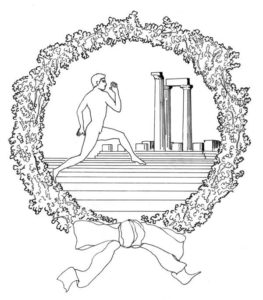
The Events
The events of the Nemean Games were held shortly after the summer solstice. Athletes came from all over Greece and even beyond to compete and were separated into three age groups: boys (12-16 years), youths (16-20) and men (over 21). They were supervised by specially trained Hellanodikai who acted as both referees and judges and wore black. Athletes competed naked and victors were awarded a crown of wild celery. The most important event was the stadion or foot-race over one length of the stadium track. Other events were foot-races over various stadium lengths: the diaulos (double), the hippios (four lengths), Dolichos (as many as twenty-four lengths) and the hoplitodromos (as the dialous but run in hoplite armor). In addition, there were competitions in boxing (pyx), wrestling (pale), combined boxing and wrestling (pankration) and the pentathlon – stadion race, wrestling, javelin (akonti), discus (diskos) and long jump (halma). Horse races were also held on the hippodrome track and included the four-horse chariot race of 8,400 m (tethrippon), the two-horse chariot race of 5,600 m (synoris) and the horse race of 4,200 m (keles). Two further competitions were for heralds (kerykes) and trumpeters (salpinktai). The winner of the first won the right to announce the sporting events and victors and the latter won the privilege of announcing the herald. In the Hellenistic period competitions in singing, flute and lyre playing were also added.
ARCHITECTURAL REMAINS
In 1884 a French archaeologist made surface excavations. Excavations were also carried out between 1924-6 by the American School of Classical Studies at Athens and again in 1964. Then more systematically from 1973 by the University of California at Berkeley and archaeologist Steven G. Miller, which continues to the present day.
Remains at the site are dominated by the impressive Temple of Zeus constructed in 330 BCE. This was built on the site of an earlier temple (6th century BCE). The new temple was built of local limestone and covered in fine marble-dust stucco with the inner sima in marble. The entrance had a large ramp rather than steps and inside was a large statue of Zeus. The temple measured approximately 22 x 42 m. The Doric exterior (peristyle) had 6 x 12 unusually slender columns, 10.33 m high. The Corinthian inner columns (6 x 4) also supported a secondary story of Ionic columns. There was no exterior decoration. The wooden and terracotta tiled roof of the temple collapsed in the 2nd century CE and in the 5th century CE, the majority of columns collapsed, due to the removal of blocks from the stylobate. Several columns have been re-erected in modern times mostly using the original drums which still lie scattered around the site.
Alongside the Temple of Zeus was an unusually long (41 m) altar but only its foundations survive. Also near the temple there is a row of nine small rectangular buildings (oikoi) built in the early 5th century BCE. In the 4th century BCE, the Macedonians added other buildings. These include a Bathhouse, the large Xenon building, a shrine to Opheltes and a triple stone reservoir (measure 3 x 9.8 m and reach a depth of 8 m; their exact function is not known).
The Bathhouse has a large central pool flanked by two tub rooms, each with four stone wash basins. The Xenon was a large rectangular building (85 x 20 m) with fourteen rooms and originally two stories but only the foundations remain (probably used as accommodation for athletes and trainers). The shrine to Opheltes was built on a small man-made mound and covered an area of 850 square meters enclosed by a low stone wall. Inside were two altars, a cenotaph to commemorate Opheltes and at least some trees, planted to form a sacred grove in a corner. The shrine was a renovation of the earlier 6th-century.
Linked by a road to the sacred complex, the stadium of Nemea which is visible today dates from 330-320 BCE and was built between two natural ridges providing an elevated vantage point for spectators and allowing a capacity as high as 30,000 people. A locker-room (apodyterion), once with an open central court, is connected to the stadium track by an arched tunnel measuring over 36 m in length and nearly 2.5 m in height. The track itself is the usual 600 ancient feet in length (178 m) with small marker posts indicating every 100 ft. Still in situ is the stone starting line (balbis) where athletes placed their front foot.
Important archaeological finds at the site include a rare double-tray sacrificial table and a range of bronze sporting equipment including javelin tips, strigils and a discus. Other finds include votive statues, jumping stones and an impressive array of coins and pottery which attest to the wide geographical appeal of the Nemean Games. Since 1996 and held every 4 years, there has been a revival of the ancient Nemean Games with footraces held in the ancient stadium.
Nafplio:
The city of Nafplio was the first capital of the modern Greek state. Named after Nafplios, son of Poseidon, and home of Palamidis, their local hero of the Trojan war and supposedly the inventor of weights and measures, lighthouses the first Greek alphabet and the father of the Sophists. The small city-state made the mistake of allying with Sparta in the second Messenian War (685-688 BC) and was destroyed by Damokratis the king of Argos.
Because of the strength of the fort that sits above the bay, the town of Nafplio became an important strategic and commercial center to the Byzantines from around the 6th century AD. In 1203 Leon Sgouros, ruler of the city, conquered Argos and Corinth and Larissa to the north, though it failed to successfully conquer Athens after a siege in 1204.
With the fall of Constantinople to the Turks, the Franks, with the help of the Venetians captured the city and nearly destroyed the fortress in the process. In the treaty, the defenders of the city were given the eastern side of the city, called the Romeiko and allowed to follow their customs, while the Franks controlled the Akronafplia, which was most of the city at the time. The Franks controlled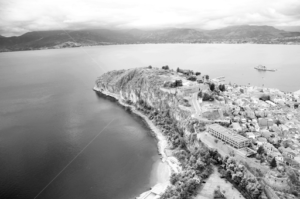 the city for 200 years and then sold it to the Venetians. The Venetians continued the fortification of the upper town and completed their work in 1470. That same year they built a fort on the small island in the center of the harbor called the Bourtzi. To close the harbor the fort was linked by chains and the town was known as Porto Cadenza, meaning Port of Chains. During this period people flocked to the safety of the fortified city in fear of the Turks and forced the expansion of the city into the lagoon between the sea and the walls of the Akronafplia. The new additions to the city were surrounded by walls and many major buildings were erected including the Church of Saint George. But these new walls didn’t matter because in the treaty with Suleiman the First, Nafplio was handed over to the Turks who controlled the city for 100 years and made it the primary import/export center for mainland Greece.
the city for 200 years and then sold it to the Venetians. The Venetians continued the fortification of the upper town and completed their work in 1470. That same year they built a fort on the small island in the center of the harbor called the Bourtzi. To close the harbor the fort was linked by chains and the town was known as Porto Cadenza, meaning Port of Chains. During this period people flocked to the safety of the fortified city in fear of the Turks and forced the expansion of the city into the lagoon between the sea and the walls of the Akronafplia. The new additions to the city were surrounded by walls and many major buildings were erected including the Church of Saint George. But these new walls didn’t matter because in the treaty with Suleiman the First, Nafplio was handed over to the Turks who controlled the city for 100 years and made it the primary import/export center for mainland Greece.
In 1686 the Turks surrendered the city to a combined force of Venetians, Germans and Poles, lead by Vice Admiral Morozini and this began the second period of Venetian rule in which massive repairs were made to the fortress and the city including the construction of the fortress in Palamidi. When the Peloponnese falls to the Venetians, Nafplio becomes the capital. But after just 30 years the Turks once again take control of the city, almost totally destroying it, looting it and killing almost all its defenders. Most of the survivors chose to leave and the city while the Turks built mosques, baths and the homes in the eastern style which can still be seen.
In April of 1821 Greek chieftains and Philhellenes surrounded the city of Nafplio and liberated it from the Turks under the leadership of Theodore Kolokotronis. Nafplio became the center of activities which would result in the formation of Modern Greece. In 1823 it becomes the capital of the state which is then recognized by the world powers (England, France, and Russia) in 1827.
 In January of 1828, Ioannis Kapodistrias is recognized as the first governor and arrives in Nafplion. In 1831 King Otto is chosen as the first King of Greece but a month later Kapodistrias is murdered in the Church of Agios Spiridon.
In January of 1828, Ioannis Kapodistrias is recognized as the first governor and arrives in Nafplion. In 1831 King Otto is chosen as the first King of Greece but a month later Kapodistrias is murdered in the Church of Agios Spiridon.
In 1833 King Otto arrives amid great fanfare to the city of Nafplio where he remains until 1834 when the capital of Greece is moved to Athens.
In 1862 there is a rebellion in Nafplio against the monarchy. A siege by the royal army follows. The rebels are given amnesty in 1862. In 1834 Kolokotronis is jailed in the Palamidi fortress. After the capital moves to Athens, the city of Nafplio becomes of less importance. But it still continues to attract visitors to this very day because its history is virtually the history of modern Greece and because every occupying power has left its mark. The city of Nafplio is like a living museum and as lively as any city in Greece.
Cancellation Policy

All cancellations must be confirmed by Olive Sea Travel.
Regarding the Day Tours:
Cancellations up to 24 hours before your service date are 100% refundable.
Cancellation Policy:
- Licensed Tour Guides and Hotels are external co-operators & they have their own cancellation policy.
- Apart from the above cancellation limits, NO refunds will be made. If though, you fail to make your appointment for reasons that are out of your hands, that would be, in connection with the operation of your airline or cruise ship or strikes, extreme weather conditions or mechanical failure, you will be refunded 100% of the paid amount.
- If your cancellation date is over TWO (2) months away from your reservation date, It has been known for third-party providers such as credit card companies, PayPal, etc. to charge a levy fee usually somewhere between 2-4%.
- Olive Sea Travel reserves the right to cancel your booking at any time, when reasons beyond our control arise, such as strikes, prevailing weather conditions, mechanical failures, etc. occur. In this unfortunate case, you shall be immediately notified via the email address you used when making your reservation and your payment WILL be refunded 100%.
Recommended for you

Athens By Night Private Tour



